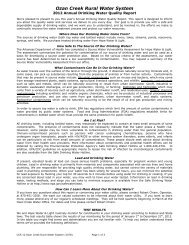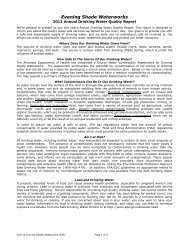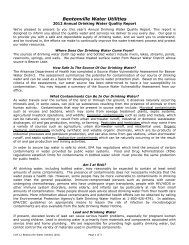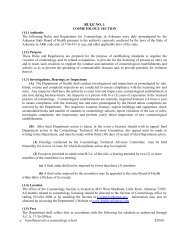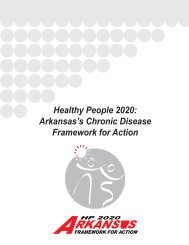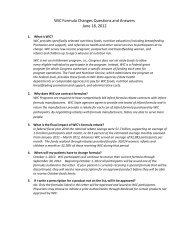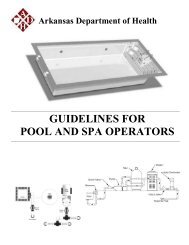Innovations in Breast Cancer Surgery - Arkansas Department of Health
Innovations in Breast Cancer Surgery - Arkansas Department of Health
Innovations in Breast Cancer Surgery - Arkansas Department of Health
You also want an ePaper? Increase the reach of your titles
YUMPU automatically turns print PDFs into web optimized ePapers that Google loves.
<strong>Innovations</strong><br />
<strong>in</strong> <strong>Breast</strong> <strong>Cancer</strong> <strong>Surgery</strong><br />
V. Suzanne Klimberg, M.D.<br />
Muriel Balsam Kohn Chair <strong>in</strong><br />
<strong>Breast</strong> Surgical Oncology<br />
Pr<strong>of</strong>essor <strong>of</strong> <strong>Surgery</strong> & Pathology<br />
University <strong>of</strong> <strong>Arkansas</strong> for Medical Sciences<br />
Director, <strong>Breast</strong> <strong>Cancer</strong> Program<br />
W<strong>in</strong>throp P. Rockefeller <strong>Cancer</strong> Institute
The greatest obstacle to<br />
discovery is not ignoranceit<br />
is the illusion <strong>of</strong><br />
knowledge.<br />
Daniel J. Boorst<strong>in</strong>
RFA: RadioFrequency Ablation<br />
Current Flow<br />
Tissue<br />
Dispersive<br />
Pad<br />
Electrode<br />
RF<br />
Generator
Radi<strong>of</strong>requency Probes<br />
Radionics & Boston Scientific<br />
•Impedence<br />
RITA-Angiodynamics<br />
•Temperature
RFA <strong>of</strong> <strong>Breast</strong> <strong>Cancer</strong>.<br />
First Report <strong>of</strong> an Emerg<strong>in</strong>g<br />
Technology<br />
Jeffrey SS, Birdwell RL Ikeda DM, et al<br />
Arch Surg 1999;134:1064<br />
• Feasability Trial<br />
• LABC (n=5)<br />
• RFA Mastectomy<br />
• Ablation zones 0-8-1.8 cm <strong>in</strong> D
RFA Ablation Trials<br />
Trialc Patients n Treatment Outcome<br />
Izzo et al, 2001<br />
(pilot)<br />
T1/2 26 US-guided RFA<br />
(marg<strong>in</strong> <strong>of</strong> ≥ 5<br />
mm)<br />
Complete coagulative<br />
necrosis <strong>in</strong> 25/26<br />
patients*<br />
Fornage, 2004<br />
Tumor ≤ 2 cm<br />
<strong>in</strong><br />
diameter<br />
21 RFA surgery Complete coagulative<br />
necrosis <strong>in</strong> 20<br />
patients<br />
S<strong>in</strong>gletary, 2002 T1 30 Intraoperative RFA <br />
excision<br />
Complete ablation <strong>in</strong><br />
87% <strong>of</strong> patients<br />
Burak et al, 2003<br />
Tumor ≤ 2 cm<br />
<strong>in</strong><br />
diameter<br />
10 RFA surgery (1-3<br />
wk later)<br />
No residual lesions<br />
detected on MRI <strong>in</strong><br />
8/9 patients †<br />
Hayashi et al, 2003<br />
Tumor ≤ 3 cm<br />
<strong>in</strong><br />
diameter<br />
(T1)<br />
22 RFA surgery (1-2<br />
wk later)<br />
Complete coagulative<br />
necrosis <strong>in</strong> 19/22<br />
patients<br />
Noguchi et al, 2006 T1 10 RFA surgery No Viable Tumor
Izzo F, et al. Radi<strong>of</strong>requency Ablation <strong>in</strong> Patients<br />
with Primary <strong>Breast</strong> Carc<strong>in</strong>oma <strong>Cancer</strong>, 92(8):<br />
2036-2044, 2001
RFA Ablation Trials<br />
Trialc Patients n Treatment Outcome<br />
Izzo et al, 2001<br />
(pilot)<br />
T1/2 26 US-guided RFA<br />
(marg<strong>in</strong> <strong>of</strong> ≥ 5<br />
mm)<br />
Complete coagulative<br />
necrosis <strong>in</strong> 25/26<br />
patients*<br />
Fornage, 2004<br />
Tumor ≤ 2 cm<br />
<strong>in</strong><br />
diameter<br />
21 RFA surgery Complete coagulative<br />
necrosis <strong>in</strong> 20<br />
patients<br />
S<strong>in</strong>gletary, 2002 T1 30 Intraoperative RFA <br />
excision<br />
Complete ablation <strong>in</strong><br />
87% <strong>of</strong> patients<br />
Burak et al, 2003<br />
Tumor ≤ 2 cm<br />
<strong>in</strong><br />
diameter<br />
10 RFA surgery (1-3<br />
wk later)<br />
No residual lesions<br />
detected on MRI <strong>in</strong><br />
8/9 patients †<br />
Hayashi et al, 2003<br />
Tumor ≤ 3 cm<br />
<strong>in</strong><br />
diameter<br />
(T1)<br />
22 RFA surgery (1-2<br />
wk later)<br />
Complete coagulative<br />
necrosis <strong>in</strong> 19/22<br />
patients<br />
Noguchi et al, 2006 T1 10 RFA surgery No Viable Tumor
RFA Ablation Trials<br />
Trialc Patients n Treatment Outcome<br />
Izzo et al, 2001<br />
(pilot)<br />
T1/2 26 US-guided RFA<br />
(marg<strong>in</strong> <strong>of</strong> ≥ 5<br />
mm)<br />
Complete coagulative<br />
necrosis <strong>in</strong> 25/26<br />
patients*<br />
Fornage, 2004<br />
Tumor ≤ 2 cm<br />
<strong>in</strong><br />
diameter<br />
21 RFA surgery Complete coagulative<br />
necrosis <strong>in</strong> 20<br />
patients<br />
S<strong>in</strong>gletary, 2002 T1 30 Intraoperative RFA <br />
excision<br />
Complete ablation <strong>in</strong><br />
87% <strong>of</strong> patients<br />
Burak et al, 2003<br />
Tumor ≤ 2 cm<br />
<strong>in</strong><br />
diameter<br />
10 RFA surgery (1-3<br />
wk later)<br />
No residual lesions<br />
detected on MRI <strong>in</strong><br />
8/9 patients †<br />
Hayashi et al, 2003<br />
Tumor ≤ 3 cm<br />
<strong>in</strong><br />
diameter<br />
(T1)<br />
22 RFA surgery (1-2<br />
wk later)<br />
Complete coagulative<br />
necrosis <strong>in</strong> 19/22<br />
patients<br />
Noguchi et al, 2006 T1 10 RFA surgery No Viable Tumor
RFA for M<strong>in</strong>imally Invasive<br />
Treatment <strong>of</strong> <strong>Breast</strong> Carc<strong>in</strong>oma. A<br />
Pilot Study <strong>in</strong> Elderly Inoperable<br />
Patients<br />
Sus<strong>in</strong>i T, Jacopo N, Olivieri S, Livi L, Bianchi S,<br />
Mangialovori G, Branconi F, Scarselli G<br />
Gynecologic Oncology 104(2007)304-310<br />
• 3 Pts (78-86yo) With
Benefits <strong>of</strong><br />
Percutaneous Ablation<br />
•M<strong>in</strong>imize Morbidity<br />
•M<strong>in</strong>imize Side-effects<br />
•Reduce Costs
Problems with<br />
Percutaneous Ablation<br />
• Incomplete Pathology<br />
• Mass Effect<br />
• Lack <strong>of</strong> Assessment <strong>of</strong><br />
Complete Ablation/Imag<strong>in</strong>g<br />
• Loss <strong>of</strong> Tumor Bank<strong>in</strong>g Tissue<br />
• Limitations <strong>of</strong> Extent <strong>of</strong> Ablation<br />
• Expertise Required
PeRFA:<br />
Percutaneous Excision &<br />
Ablation<br />
STEREO Vs US-GUIDED BX<br />
MRI<br />
LASER<br />
RF<br />
NCI Sponser Trial<br />
Ethicon/RITA<br />
EBB
Disease Extension<br />
• Holland R, et al. <strong>Cancer</strong>:56:979;1985<br />
– Gross Total Excision<br />
• Imamura H, et al BCRT 62:177;2000<br />
• Ohtake T, et al.<br />
– <strong>Cancer</strong> 76:32;1995<br />
• Vic<strong>in</strong>i T, et al.<br />
64 y.o. - 5.28 mm<br />
>50 y.o. - 6.7 – 7.7 mm<br />
Reexcision - 90%
<strong>Breast</strong> <strong>Cancer</strong> Resection and Volume
<strong>Breast</strong> <strong>Cancer</strong> Resection and Volume<br />
2cm<br />
=4cc
<strong>Breast</strong> <strong>Cancer</strong> Resection and Volume<br />
4 cc<br />
4 cm= 32cc
<strong>Breast</strong> <strong>Cancer</strong> Resection and Volume<br />
6 cm= 108cc<br />
4 cc<br />
32cc<br />
•Average Resection Size
<strong>Breast</strong> <strong>Cancer</strong> Resection and Volume<br />
6 cm= 108cc<br />
4o% Close or + Marg<strong>in</strong>s<br />
4 cc<br />
32cc<br />
•Average Resection Size
<strong>Breast</strong> <strong>Cancer</strong> Resection and Volume<br />
8 cm= 256cc<br />
4 cc<br />
32cc<br />
108cc<br />
256cc
Al-Chazal et al
M<strong>in</strong>imally Invasive EBB
US-Directed Marg<strong>in</strong><br />
Ablation<br />
• RF Vs Laser<br />
to ablate a 1<br />
cm marg<strong>in</strong>
HUG
Real-Time Visualization <strong>of</strong><br />
Extent <strong>of</strong> PeRFA
Post Ablation<br />
Lumpectomy
Lumpectomy Site Ablation<br />
• Ablate Tissue
Percutaneous Exision<br />
& Ablation<br />
• 21 Patients<br />
• Laser Arm Stopped<br />
• 14 patients <strong>in</strong> eRFA arm<br />
–100% Complete Ablation<br />
–7 with Dead Tumor Present<br />
at Excision Site
Percutaneous<br />
Excision & Ablation<br />
Advantages<br />
• Complete Pathologic Information<br />
• Ablate Marg<strong>in</strong>s <strong>in</strong>stead <strong>of</strong> Excise<br />
• Doppler Can Image Process<br />
• Could obviate need for Open<br />
<strong>Surgery</strong> & XRT
Percutaneous<br />
Excision & Ablation<br />
Disadvantages<br />
• Required Expertise<br />
• Size Limited Group<br />
–≤1.5 cm<br />
–≥1.0 cm from Sk<strong>in</strong>
RFA-Assisted Lumpectomy<br />
eRFA
eRFA More than DoublesTreated<br />
Volume <strong>of</strong> Tissue Without Further<br />
Resection<br />
eRFA<br />
Average<br />
6 cm Resection<br />
108cc<br />
256cc
PeRFA<br />
May Represent a Paradigm<br />
Shift <strong>in</strong> the Treatment <strong>of</strong><br />
<strong>Breast</strong> <strong>Cancer</strong>
<strong>Breast</strong> TeamTM<br />
Acknowledgements<br />
• Cristiano Boneti, MD Jim Coad, MD<br />
• Isabel Rubio, MD Gal Shafirste<strong>in</strong>, PhD<br />
• Lynette Smith, MD Milton Waner, MD<br />
• Ronda Henry-Tillman, MD Scott Ferguson<br />
• Julie Kepple, MD Valent<strong>in</strong>a Todorova, PhD<br />
• Anita Johnson, MD Rak Layeeque, MD<br />
• Steve Harms, MD Aaron Margulies, MD<br />
• Kent Westbrook, MD Soheila Korourian, MD<br />
• Maureen Colvert, BS,OCN Shiela Mumford<br />
• Laura Adk<strong>in</strong>s, MS Roberta Clark, BS
Conservative <strong>Breast</strong> <strong>Surgery</strong><br />
• >150,000 Lumpectomies per Yr<br />
• Conserve the <strong>Breast</strong> by Remov<strong>in</strong>g <strong>Cancer</strong><br />
with a Tumor-free Zone or Marg<strong>in</strong>.<br />
– Conservative <strong>Breast</strong> <strong>Surgery</strong><br />
– Lumpectomy<br />
– Segmentectomy<br />
– Partial Mastectomy<br />
Vs<br />
– Excisional <strong>Breast</strong> Biopsy used for Benign
Pos<br />
Problem: 40% <strong>of</strong> Patients<br />
Have Re-excisions Secondary<br />
To Close or Positive Marg<strong>in</strong>s
Needle Localization <strong>Breast</strong><br />
Biopsy<br />
Risk <strong>of</strong> + Marg<strong>in</strong>s<br />
• Primary means <strong>of</strong><br />
target<strong>in</strong>g<br />
mammographic<br />
abnormalities<br />
• 40 to 75% + Marg<strong>in</strong>s
Marg<strong>in</strong> Negativity is<br />
the Only Prognostic<br />
Factor that Surgeons<br />
Can Affect
Def<strong>in</strong>ition <strong>of</strong> a Negative<br />
Marg<strong>in</strong><br />
• One Cell to One Centimeter<br />
• Recurrence Rate < 3 mm -Freedman<br />
et al Int J Rad Onc Biol Phys 1999. 15;44(5):1005<br />
• LRR after CBS – 7% 14% 27%<br />
for Extensive, Focal or (-) Marg<strong>in</strong>s<br />
– Park et al JCO 2000;18(8):1668-75
Problems with Pathology<br />
• Intraoperative Pathology Not<br />
Accurate for Depth <strong>of</strong> Marg<strong>in</strong>s<br />
• Permanent Pathology only an<br />
Estimation <strong>of</strong> What is There<br />
- Only Test ~1/1000 <strong>of</strong> Marg<strong>in</strong><br />
Carter et al
Surgical Excision
Excised Lumpectomy Specimen<br />
+ Marg<strong>in</strong>s<br />
•Positive marg<strong>in</strong>s
•Carter Estimated Needed 3,000 Sections Through<br />
a 2cm Tumor to Accurately Assess the Marg<strong>in</strong>s<br />
•Pathology Assesses ~ 1/1000 <strong>of</strong> The Marg<strong>in</strong><br />
Modern Day Pathology Only Estimates<br />
The Surgical Marg<strong>in</strong>
Whole Mount <strong>of</strong> Invasive <strong>Breast</strong> <strong>Cancer</strong>
Path Section<strong>in</strong>g Can Miss + Marg<strong>in</strong>s
Residual <strong>Cancer</strong> Found<br />
After Re-excision<br />
• Negative (>2mm) – 12-26%<br />
• Close (
Residual Disease on Re-Excision by<br />
Initial Resection Marg<strong>in</strong> Width
Residual Disease on Re-Excision by<br />
Initial Resection Marg<strong>in</strong> Width
Residual Disease on Re-Excision by<br />
Initial Resection Marg<strong>in</strong> Width
<strong>Breast</strong> Lumpectomy Marg<strong>in</strong><br />
Predicts Residual Tumor Burden<br />
<strong>in</strong> DCIS <strong>of</strong> the <strong>Breast</strong><br />
Residual Tumor Burden<br />
Initial Excision Marg<strong>in</strong>
Disease Extension<br />
• Holland R, et al. <strong>Cancer</strong>:56:979;1985<br />
– Gross Total Excision, T2<br />
• Imamura H, et al BCRT 62:177;2000<br />
• Ohtake T, et al.<br />
– <strong>Cancer</strong> 76:32;1995<br />
• Vic<strong>in</strong>i T, et al.<br />
64 y.o. - 5.28 mm<br />
>50 y.o. - 6.7 – 7.7 mm<br />
Reexcision - 90%
eRFA Concept
eRFA Simulated<br />
Lumpectomy<br />
•Obta<strong>in</strong> Pre-Cl<strong>in</strong>ical Data<br />
•Ex Vivo Mastectomy<br />
•Simulated lumpectomy<br />
•Ex Vivo RFA<br />
•15 m<strong>in</strong>utes at 100º<br />
•Excision <strong>of</strong> Lumpectomy<br />
•Whole Mount Reconstruction<br />
Simulated<br />
Tumor<br />
Bed
Ex Vivo Simulated Lumpectomy
Ex Vivo Simulated Lumpectomy
Ex Vivo Simulated Lumpectomy
Lumpectomy Site Ablation<br />
Korourian<br />
November 19, 2003<br />
Confidential
Ex Vivo Simulated Lumpectomy
Shafirste<strong>in</strong>
3-D Reconstruction Of<br />
Lumpectomy Cavity Ablation<br />
Gal Shafirste<strong>in</strong>, PhD<br />
Cavity Entrance<br />
1 cm<br />
1mm
Kwan
Coad<br />
Simulated Lumpectomy<br />
& eRFA
Todorova & Thomas et al<br />
Molecular Marg<strong>in</strong><br />
HSP 27<br />
Cytoplamic & Membrane Sta<strong>in</strong><strong>in</strong>g<br />
Zone 3<br />
3+<br />
30%<br />
cells<br />
Zone 2<br />
3+<br />
80% cells<br />
Zone 1<br />
Negative<br />
Zone 3 Zone 2 Zone 1 (ABLATION ZONE)
RFA-Assisted Lumpectomy<br />
eRFA
eRFA for <strong>Breast</strong> <strong>Cancer</strong>:<br />
Excision Followed by RFA
Sk<strong>in</strong><br />
Real-Time Visualization <strong>of</strong><br />
Cavitary Ablation<br />
ABLATION<br />
zONE<br />
Lumpectomy<br />
Cavity
Cavitary Biopsies
PCNA <strong>of</strong> Pre- & Post-Ablation<br />
RFA-Assisted Lumpectomy<br />
• Biopsies <strong>of</strong> Ablated Cavity all > 12+5 mm<br />
Pre-Ablation Biopsy<br />
Post-Ablation Biopsy<br />
Korourian et al
PCNA <strong>of</strong> Pre- & Post-Ablation<br />
RFA-Assisted Lumpectomy<br />
• Biopsies <strong>of</strong> Ablated Cavity all > 12+5 mm<br />
Pre-Ablation Biopsy<br />
Post-Ablation Biopsy<br />
Korourian et al
6 months Post eRFA<br />
Without XRT
F<strong>in</strong>cher et al
Brito & Borrelli et al
eRFA for Marg<strong>in</strong>s<br />
Klimberg VS, Korourian S, Kepple JA, Henry-Tillman RS, Shafirste<strong>in</strong> G<br />
Annals <strong>of</strong> Surgical Oncology<br />
• 41 Pts with DCIS, T1 & T2 IBC for CBS<br />
• Tumor Size: 1.5 + 1.1 cm<br />
• All patients had lumpectomy and RFA<br />
• 24 Month Median Follow-up<br />
• Results:<br />
– 25% had Inadequate Marg<strong>in</strong>s <strong>of</strong> < 2 mm<br />
– ~1/2 <strong>of</strong> All Pts Benefited<br />
– Very Good cosmesis and imag<strong>in</strong>g results
eRFA<br />
Positive IOP Marg<strong>in</strong>s<br />
Negative IOP Marg<strong>in</strong>s (41)<br />
Re-Resection<br />
1 Grossly+<br />
F<strong>in</strong>al Path<br />
10 Close/+ 31 Neg<br />
Potential RFA Impact<br />
9* + 8** = 17/40<br />
43% <strong>of</strong> All Pts<br />
8
eRFA<br />
Klimberg VS, Korourian S, Kepple JA, Henry-Tillman RS, Shafirste<strong>in</strong> G<br />
• 80 Patients<br />
• 24 Mo Median Follow-up (Range 7 to 55 Mo)<br />
• Results:<br />
– 60 did not have XRT after eRFA<br />
– 4 Had XRT Prior to eRFA<br />
– 2 Re-Excised for Rema<strong>in</strong><strong>in</strong>g Calcifications<br />
– 2 Re-Excised for Grossly Positive Marg<strong>in</strong>s<br />
– No Insite LR<br />
– 2 Elsewhere Recurrence<br />
– Post op Complications – 7.5%
Potential Advantages <strong>of</strong><br />
eRFA<br />
nnnnnnnn <strong>in</strong> <strong>Breast</strong> <strong>Cancer</strong><br />
• Re-Excisions<br />
• Recurrences<br />
• For Treatment <strong>of</strong> Favorable <strong>Breast</strong><br />
<strong>Cancer</strong>s<br />
• Salvage after LR <strong>in</strong> Irradiated<br />
<strong>Breast</strong><br />
• Replace Boost <strong>in</strong> T2 <strong>Cancer</strong>s<br />
• May Impact Survival
eRFA<br />
Tra<strong>in</strong><strong>in</strong>g <strong>in</strong><br />
For <strong>Breast</strong> <strong>Cancer</strong><br />
• Italy<br />
• Spa<strong>in</strong><br />
• Germany<br />
• Canada<br />
• United States >10 States<br />
• Registry Start<strong>in</strong>g<br />
• klimbergsuzanne@uams.edu
Italian Trial<br />
• Lumpectomy + eRFA<br />
• Followed by<br />
Quadrantectomy<br />
• Determ<strong>in</strong>e Marg<strong>in</strong> Ablation
Coad
eRFA<br />
Klimberg VS, Korourian S, Kepple JA, Henry-Tillman RS, Shafirste<strong>in</strong> G<br />
• 80 Patients<br />
• 24 Mo Median Follow-up (Range 7 to 55 Mo)<br />
• Results:<br />
– 60 did not have XRT after eRFA<br />
– 4 Had XRT Prior to eRFA<br />
– 2 Re-Excised for Rema<strong>in</strong><strong>in</strong>g Calcifications<br />
– 2 Re-Excised for Grossly Positive Marg<strong>in</strong>s<br />
– No Insite LR<br />
– 2 Elsewhere Recurrence<br />
– Post op Complications – 7.5%
Presently High Failure Rate<br />
after Lumpectomy Alone for<br />
Treatment <strong>of</strong> LR <strong>in</strong> the<br />
Radiated <strong>Breast</strong> Mandates<br />
Mastectomy<br />
• 32% LRR for Excision Alone<br />
• 51 Month Follow-Up<br />
Kurtz et al
SWOG Concept: Excision Followed by RFA<br />
for Salvage <strong>of</strong> Recurrence Follow<strong>in</strong>g <strong>Breast</strong><br />
Conservation<br />
Salvage eRFA<br />
BCS with XRT<br />
Standard<br />
Lumpectomy<br />
Resectable 50<br />
eRFA<br />
RFA <strong>of</strong><br />
Cavity<br />
Lumpectomy<br />
Ablation Specimens<br />
Pathology
Adjuntive <strong>Breast</strong> Lumpectomy<br />
with RF Ablation<br />
Treatment to reduce re-Excision<br />
& recurrence: ABLATE Trial<br />
DCIS or<br />
IDC < 2 cm<br />
eRFA<br />
BCS with<br />
XRT
Adjuntive <strong>Breast</strong> Lumpectomy with RF Ablation<br />
Treatment to reduce re-Excision & recurrence<br />
ABLATE Registry<br />
Standard<br />
Lumpectomy<br />
eRFA<br />
<strong>of</strong><br />
Cavity<br />
Lumpectomy<br />
Ablation Specimens<br />
Pathology
eRFA<br />
May Represent a Paradigm<br />
Shift <strong>in</strong> the Treatment <strong>of</strong><br />
<strong>Breast</strong> <strong>Cancer</strong>
The Era<br />
is <strong>in</strong> the Marg<strong>in</strong>
Axillary Reverse Mapp<strong>in</strong>g (ARM):<br />
A New Concept to Identify &<br />
Enhance Lymphatic Preservation
Stag<strong>in</strong>g <strong>of</strong> the Axillary Lymph Nodes<br />
• Stag<strong>in</strong>g <strong>of</strong> the Axillary Lymph Nodes is the<br />
Number 1 Predictor <strong>of</strong> How Well a Patient Will Do<br />
– CTX and XRT plans may change dependent upon the<br />
number and extent <strong>of</strong> axillary lymph node <strong>in</strong>volvement.<br />
• Techniques for stag<strong>in</strong>g the axilla have evolved<br />
from a level I-III or full axillary lymph node<br />
dissection (ALND) ~15-50% arm lymphedema rate.<br />
• to a level I and II ALND<br />
~5-15% lymphedema rate.
SLN Concept
SLN Concept
SLN Concept
Stag<strong>in</strong>g <strong>of</strong> the Axillary Lymph Nodes<br />
• Stag<strong>in</strong>g <strong>of</strong> the Axillary Lymph Nodes is the<br />
Number 1 Predictor <strong>of</strong> How Well a Patient Will Do<br />
– CTX and XRT plans may change dependent upon the<br />
number and extent <strong>of</strong> axillary lymph node <strong>in</strong>volvement.<br />
• Techniques for stag<strong>in</strong>g the axilla have evolved<br />
from a level I-III or full axillary lymph node<br />
dissection (ALND) ~15-50% arm lymphedema rate.<br />
• to a level I and II ALND ~5-15% lymphedema rate.<br />
• to that <strong>of</strong> SLNB ~1%-13%.
Hypothesis<br />
We hypothesized that variations <strong>in</strong><br />
arm lymphatic dra<strong>in</strong>age put the arm<br />
at risk for lymphedema secondary to<br />
disruption dur<strong>in</strong>g a SLNB &/or<br />
ALND.
Foldi<br />
Problem
Foldi<br />
Problem
Hypothesis<br />
Therefore Mapp<strong>in</strong>g the Dra<strong>in</strong>age <strong>of</strong><br />
the Arm with Blue Dye:<br />
Axillary Reverse Mapp<strong>in</strong>g (ARM)<br />
Would the Likelihood <strong>of</strong><br />
Disruption <strong>of</strong> the Arm Lymphatics<br />
and Subsequent Lymphedema.
ARM Concept<br />
AnnSurgOnc 2007;14(2):84.
ARM Concept<br />
AnnSurgOnc 2007;14(2):84.
ARM Concept<br />
AnnSurgOnc 2007;14(2):84.
ARM Concept<br />
AnnSurgOnc 2007;14(2):84.
ARM Concept<br />
AnnSurgOnc 2007;14(2):84.<br />
ALND
ARM:<br />
Axillary<br />
Reverse<br />
Mapp<strong>in</strong>g
Blue Arm<br />
Lymphatics
Blue Arm<br />
Lymphatics
Axillary Ve<strong>in</strong>
Axillary Reverse Mapp<strong>in</strong>g (ARM): A<br />
New Concept to Identify & Enhance<br />
Lymphatic Preservation.<br />
AnnSurgOnc 2007;14(2):84.
Initial ARM Results<br />
ID<br />
Hot & Blue<br />
Subareolar<br />
Isotope<br />
Only<br />
SLNB 60/62<br />
(97%)<br />
0/60<br />
(0%)
Initial ARM Results<br />
ARM Blue<br />
Lymphatic<br />
ID <strong>in</strong> Axilla<br />
ARM<br />
Blue<br />
and Hot<br />
ARM +<br />
Axilla+<br />
ALND 18/21<br />
(85%)<br />
0/18<br />
(0%)<br />
0<br />
8
ARM Initial<br />
Blue Lymphatic<br />
Identified <strong>in</strong><br />
Axilla<br />
Radioactive<br />
SLNB Only 22/62 (35%)
Conclusions<br />
• There was non-concordance <strong>of</strong> arm & breast<br />
lymphatic dra<strong>in</strong>age even <strong>in</strong> heavily positive<br />
axillas.<br />
• There were cl<strong>in</strong>ically significant lymphatic<br />
variations that ARM identified & allowed<br />
preservation <strong>in</strong> all but one case.<br />
• ARM added to ALND as well as SLNB further<br />
del<strong>in</strong>eates the axilla & may help prevent<br />
lymphedema.
Proposed ARM Study<br />
• Pts Undergo<strong>in</strong>g SLN+ALND<br />
• ARM<br />
• Record Non-Concordance<br />
– SLN ID Rate & Hot but not Blue<br />
– ID Rate <strong>of</strong> Blue ARM Lymphatic & Blue but<br />
Not Hot<br />
• In first 5 ALND-Remove Blue Node with ALND<br />
– Record Percent Blue ARM Nodes that Path+<br />
• Rema<strong>in</strong><strong>in</strong>g Cases - Determ<strong>in</strong>e Ability to<br />
– ID, Dissect Free and Spare Blue ARM Node<br />
• Record Lymphedema over Time



